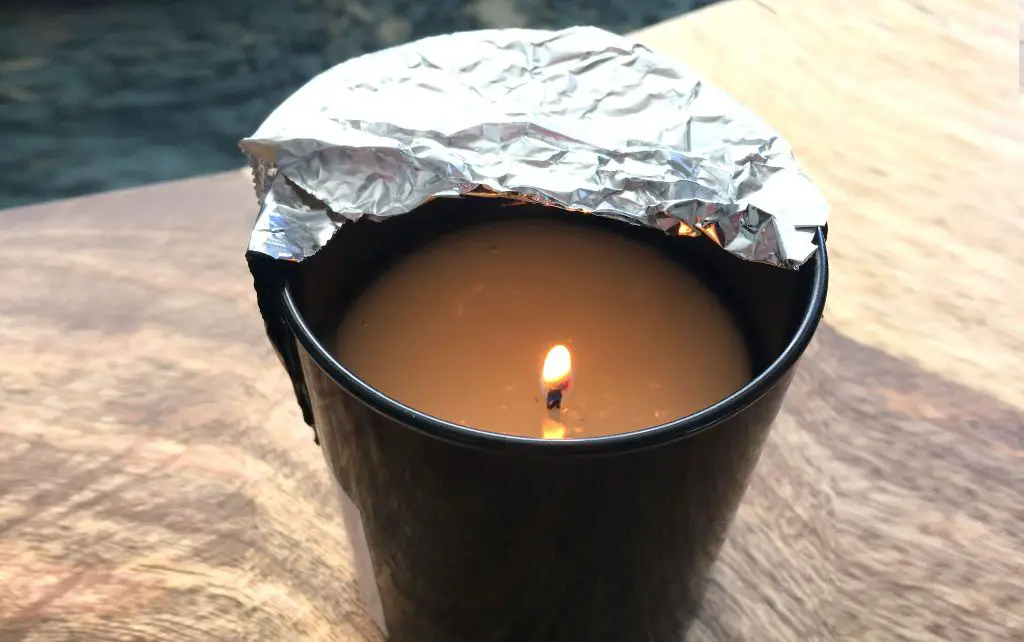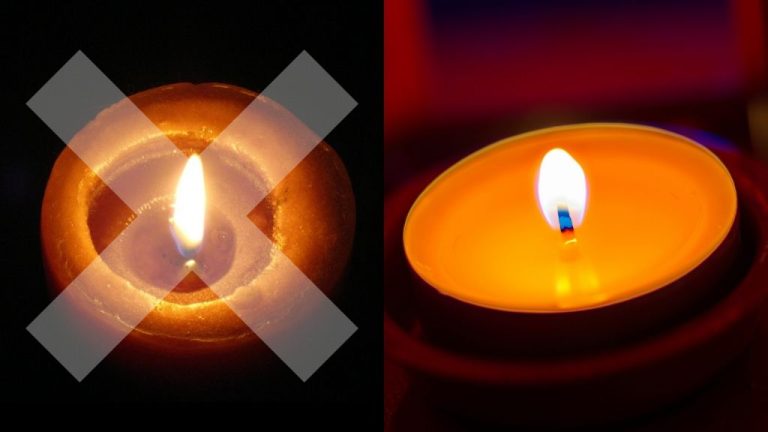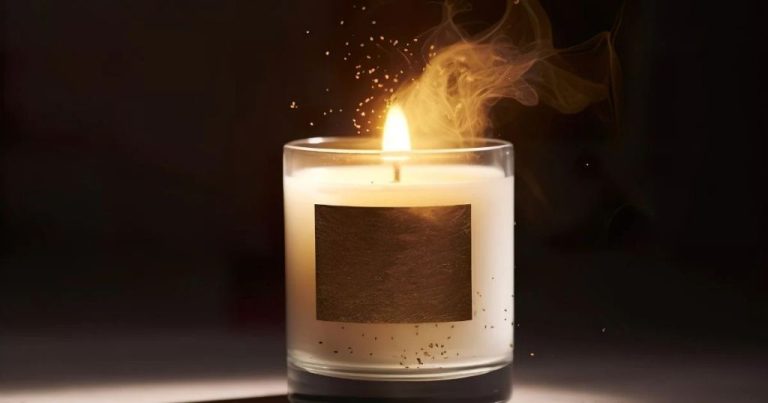How Do You Burn A Candle When The Wick Is Gone?
The Problem of a Missing Wick
The wick is an essential component in a candle. According to Quora, the purpose of a wick is to transfer heat from the flame to the wax in order to melt it and keep the candle burning. Without a wick, the candle cannot remain lit.
When a candle is burned, the flame melts the wax at the top of the candle. This melted wax is then drawn up the wick through capillary action. As the liquefied wax reaches the flame through the wick, it vaporizes and combusts. This capillary action of the wick drawing up the wax fuel to feed the flame is key to sustaining combustion.
If the wick burns down completely or falls out of the candle, this capillary action stops. Without a wick to deliver wax to the flame, the candle can no longer vaporize wax to burn. The candle will go out without a properly sustained wick.
Understanding How Candles Work
Candles are able to produce light and fragrance through a chemical reaction. The candle wick plays a key role in this process. The wick is generally made from braided cotton and sits in the center of the candle wax.
Through a phenomenon called capillary action, the wax is drawn up the wick like water through a paper towel. Capillary action occurs when the adhesive forces between the liquid and a solid surface override the cohesive forces inside the liquid itself. This causes the liquid to flow up the solid surface.
As the wax is pulled up the wick, it reaches the lit tip where it vaporizes. The heat of the flame melts the solid wax into a liquid fuel. This liquid wax is then drawn up the wick where it vaporizes at the burning tip. As the wax vapor combusts, it produces both light and fragrance.
The capillary action continues to automatically deliver more wax to the flame as long as the candle continues to burn. This sustains the chemical reaction and allows the candle to keep producing light and fragrance until all the wax is used up or the wick can no longer access the liquid wax.
So in summary, the wick enables capillary action which delivers the solid wax to the flame. The heat melts the wax into a liquid fuel source so it can vaporize and combust to produce the candle’s light and fragrance. The wick is thus an essential facilitator in this chemical process.
Methods to Relight a Candle
If your candle runs out of wax but still has some remaining around the edges, there are a few methods you can try to relight it without a wick.
Using Foil or Tissue Paper
Aluminum foil or thin tissue paper can act as a makeshift wick to relight a candle. Simply roll up a small piece of foil or tissue paper into a thin cylinder. Carefully stick the end of the foil/paper into the melted wax, making sure it reaches the bottom. Light the top end of the foil/paper wick with a match or lighter. The foil or tissue paper will burn slowly, melting the wax pool so the candle can be relit.

Wick Trimming and Re-centering
If the wick has burned down but some is still visible, you may be able to trim and re-center it. Use scissors or nail clippers to trim the wick so it is uniform and straight. Then gently push and center the wick into the melted wax so it is positioned upright. Allow the wax to cool and harden before relighting. This helps ensure the wick will burn slowly and evenly.
Adding a New Wick
You can add a new wick to a candle if the old wick has burned away completely. Purchase wick material or use cotton string or twine. Cut a length about 1/2 inch longer than the candle diameter. Use a wick stick or skewer to push the new wick into the center of the wax, making sure it reaches the bottom. Let the candle wax fully cool and harden before lighting the new wick.
Using Foil or Tissue Paper
One commonly recommended technique to relight a candle with no wick is to use aluminum foil folded into a point or tissue/paper twisted into a point. The foil or tissue paper acts as a makeshift wick that you can light to melt down the wax and expose the original wick.
To use this method:
- Tear off a small piece of aluminum foil, about 2-3 inches long.
- Fold or roll up one end into a tight point about 1/2 inch long. Make sure the rest of the foil is flat.
- Carefully poke the foil point into the center of the melted wax pool until it touches the bottom.
- Light the foil point wick with a lighter or match. It may take a few tries to get it lit.
- Let the foil wick burn down into the wax, melting the wax pool evenly. Blow it out before it burns down too far.
- Once the wax pool is melted down, you should be able to trim and expose the original wick.
You can also twist tissue paper or a small strip of paper into a pointed wick shape. This is a bit more challenging to light but also works to melt down the wax pool gradually.https://www.bhg.com/news/aluminum-foil-candle-hack/
When using this foil or tissue paper method, work carefully to avoid getting burned. Have a heat-safe surface underneath and don’t leave the candle unattended. Stop and re-center the wick as needed if the wick starts to burn off-center. With patience, this can expose the original wick for relighting.
Wick Trimming and Re-centering
If the wick in your candle becomes uneven, bent, or off-center, it can often be fixed by trimming back the wax and re-centering the existing wick. Carefully trim back the wax around the wick using candle scissors or a sharp knife until you reveal the full length of the old wick. Be sure not to cut the wick itself. Once the wick is fully exposed, gently straighten and re-center it using tweezers or pliers. Apply heat from a lighter or match to soften the wax, then hold the wick in place in the center as the wax hardens again [1]. The wick should now be straightened and ready to be lit again.
You can also pour off any excess wax to lower the candle height and bring the wick closer to the center. Heating the candle with a hair dryer or heat gun will make the wax more pliable for re-centering the wick. Work slowly and carefully to avoid snapping the wick. With some patience, trimming and straightening the existing wick can restore many crooked or off-center candles.
Adding a New Wick
If the existing wick has burned down too far or fallen out completely, you may need to add a brand new wick to continue enjoying your candle. There are a few different materials you can use for a replacement wick:
- Cotton string or twine – This is the most common and inexpensive wick material. Make sure to use 100% cotton and not synthetic fibers.
- Pre-tabbed wicks – You can purchase packs of pre-cut and tabbed wicks made specifically for candle making. These are easy to insert into the wax.
- Wooden toothpicks – These work in a pinch since they are absorbent. You’ll need to bundle a few together for the right thickness.
To insert a new wick:
- Use a skewer or sharp knife to poke a hole through the center of the wax, going all the way to the bottom of the container.
- Thread your new wicking material through the hole, leaving enough excess at the top to be exposed.
- You may want to secure the bottom of the wick to a penny, washer, or sticker so it stays weighted at the bottom of the candle.
- Trim the top of the wick to about 1/4″ length to prepare for lighting.
Be careful not to damage the wax too much. If the candle walls have melted down thin, you may want to transfer everything to a new container instead.[1]
Safety Tips
When relighting candles by adding your own wicks, it’s crucial to keep fire safety in mind. Melted wax can ignite easily, so take precautions. According to the U.S. Fire Administration, candles cause around 9% of home fires and 4% of home fire deaths each year (https://www.usfa.fema.gov/prevention/home-fires/prevent-fires/candle/). Follow these tips for safely handling melted wax and DIY wicking:
Work on a nonflammable surface like a metal cookie sheet to contain any wax spills or drips. Keep the candle away from anything flammable including curtains, books, and carpet.
Use the buddy system – have someone with you to assist and get help in case of burns. Treat melted wax like you would a pot of boiling water, taking extreme caution.
Wear heat-resistant gloves and safety goggles in case hot wax spatters. Tie back long hair.
Keep a fire extinguisher, damp towel, and bowl of water nearby in case the wax or wick ignite.
Avoid leaning over the candle as you work. Drip and spill the wax as minimally as possible.
Let the wax fully cool and harden before handling the candle. Be very careful adding a new wick to hot wax.
Never leave a burning candle unattended. Snuff it out if you need to step away. Store candles safely out of reach of children and pets.
With some simple precautions, you can safely rewick candles and enjoy them responsibly.
When to Toss the Candle
There comes a point when a candle is too far gone and needs to be discarded. Here are some signs it’s time to get a new candle:
The wax pool has become very shallow or nonexistent. This makes it difficult for the wax to melt and release fragrance properly. Shallow pools also make tunnels more likely to form.
The edges are very distorted or slanted. Extreme distortion prevents the wax from pooling and burning evenly. The wick will struggle to stay centered.
Soot buildup covers more than 50% of the glass. Excess soot is a fire hazard and makes the candle unpleasant to look at. Some soot is normal, but too much is a red flag.
An unpleasant or rancid scent develops. If a candle starts to smell bad when burning, the fragrance oils have likely expired.
The wax seems gritty or grainy. This texture prevents a smooth melt pool. Gritty wax also clogs wicks.
The wick can’t stay centered no matter what you try. A wick that stubbornly leans or moves to the edge means the candle can’t burn properly.
You’ve had the candle for over 2 years. Candle oils lose potency over time. Old candles are unlikely to smell or burn their best.
If one or more of these signs apply, it’s usually best to retire the candle and start fresh with a new one. Clinging to a candle past its prime rarely improves the experience.
Candle Wick Maintenance
Proper candle wick maintenance is essential for ensuring your candle burns cleanly and lasts as long as possible. As you burn your candle, the wick will get longer and may start to bend over into the wax or candle side. Trimming the wick helps the candle burn evenly and prevents excess soot.
Use small candle wick trimmers or nail clippers to trim wicks. Clip the dark tip of the wick, removing just 1/4″ to 1/2″ at a time. Make sure not to trim the wick down so far that you remove the full width of the wick braid. Trim as needed, usually after an hour or two of burn time. Straighten any wicks that have bent over into the wax so they stand upright.
To help wicks last longer, avoid letting candles burn out completely or burn with wild, uneven flames. Trim wicks before each use to remove any mushrooming or carbon buildup. Store candles tightly covered between uses so wicks don’t become dried out. With proper wick trimming and maintenance, your candle’s wicks will provide an even, clean burn from first light to the very bottom of the wax.
Source: https://www.freepatentsonline.com/y2005/0039335.html
Enjoying Candles Responsibly
Candles can create ambiance and warmth, but they also come with fire risks that need to be properly managed. According to the National Fire Protection Association (NFPA), candles cause an estimated 7,400 house fires every year in the U.S. (NFPA). Follow these tips for fire safety:
- Never leave burning candles unattended. Extinguish candles before leaving a room.
- Keep candles away from flammable items like curtains, books, and decorations.
- Place candles in sturdy, non-flammable holders that won’t tip over.
- Avoid using candles in bedrooms and sleeping areas.
- Don’t burn candles near pets or small children.
- Trim wicks to 1⁄4 inch before lighting to avoid high flames.
- Always burn candles on a heat-safe surface.
For an eco-friendly option, try soy, beeswax, or vegetable-based candles made from natural materials. Avoid candles with synthetic fragrances and paraffin wax, which is a petroleum byproduct. Properly extinguish and dispose of candle wax and remnants once the candle can no longer be burned to avoid waste.
With a few safety steps, you can safely enjoy candles and their cozy ambiance. But always practice fire safety first and never leave burning candles unattended.






